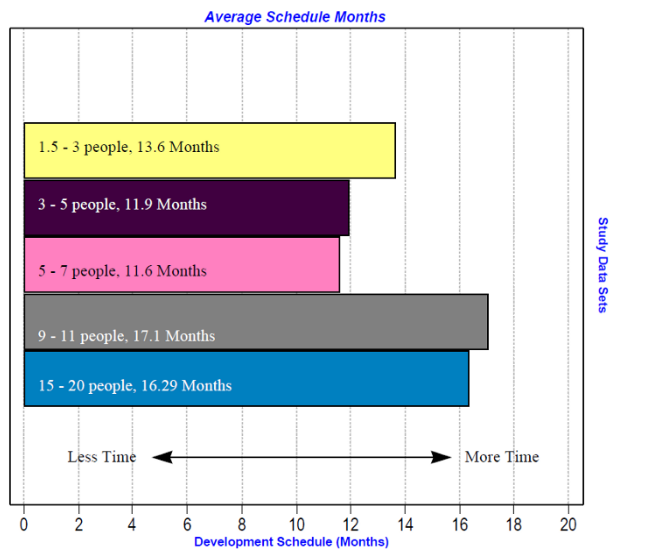بیشتر چابک و اسکرام دورههای آموزشی به قاعده ۷ ± ۲ اشاره دارند، یعنی، چابک یا تیمهای اسکرام باید ۵ تا ۹ عضو داشته باشند. اسکرام علاقهمندان ممکن است به یاد داشته باشند که اسکرام راهنما میگوید تیمهای اسکرام نباید کمتر از ۳ یا بیشتر از ۹ باشد. این قاعده thumb از کجا آمده است؟ و چرا؟
یک مطالعه که توسط لورنس اچ. پاتنام و ویر مایرز در سال ۱۹۹۸ انجام شد، به بررسی اندازه تیم پرداخت. یافتههای آنها در سال ۱۹۹۸ در کنسرسیوم کاتر منتشر شد. پاتنام و مایرز به ۴۹۱ پروژه با اندازه متوسط نگاه کردند، پروژههایی که بین ۳۵,۰۰۰ تا ۹۵,۰۰۰ خط کد «جدید یا اصلاح شده» داشتند. همه آنها سیستمهای اطلاعاتی بودند و بین سالهای ۱۹۹۵ تا ۱۹۹۸ (سه سال آخر قبل از انتشار) تکمیل شدند.

آنچه پاتنام و مایرز تأیید کردند این بود که نه تنها تیمهای کوچکتر از پنج تا هفت نفر در زمان کمتری کار را تحویل میدهند، بلکه افزایش قابل توجهی در تلاش زمانی رخ میدهد که اندازه تیم به نه یا بیشتر برسد.
دیگران چه گفتند؟
بر اساس پستی که منتشر شده است در دانشگاه وارتون پنسیلوانیا وبسایت:
آیا باید تیم پربازدهترین ۴.۶ عضو داشته باشد، همانطور که در مقاله اخیر «چگونه یک تیم عالی بسازیم» در مجله فورچون پیشنهاد شده است؟ چه طور درباره نامگذاری پنج یا شش فرد برای هر تیم، که تعداد دانشجویان MBA است که هر سال توسط وارتون برای ۱۴۴ تیم یادگیری جداگانه انتخاب میشوند؟
آیا درست است که تیمهای بزرگتر به سادگی از هم میپاشند، که نشاندهنده تمایل به «تنبلی اجتماعی» و از دست دادن هماهنگی است؟ یا اینکه به سادگی هیچ عدد جادویی برای تیم وجود ندارد، و این واقعیت را شناسایی میکند که بهترین تعداد افراد به وظیفه تیم و نقشهایی که هر فرد ایفا میکند بستگی دارد؟
خلاصه
راهنمای اسکرام توصیه میکند که اندازه تیم توسعه باید بین ۳ تا ۹ باشد. قاعده جادویی ۷ ± ۲ — از یک مقاله روانشناسی به نام «عدد جادویی هفت، به علاوه یا منهای دو: برخی محدودیتها در ظرفیت ما برای پردازش اطلاعات» که نشان میدهد محدودیتهایی در میزان اطلاعاتی که میتوانیم در ذهن خود نگه داریم وجود دارد.
هنگام کار با مشاوران تیم، اندازه مناسب تیم باید بین چهار تا شش عضو اصلی باشد، که به شما اجازه میدهد بین یک تا سه مشاور اضافه کنید در حالی که اندازه تیم را به درستی حفظ میکنید. به یاد داشته باشید، مشاوران خواهند آمد و خواهند رفت، اما تیم اصلی باید ثابت بماند.
This post is also available in Deutsch, English, Español, Français, Bahasa Indonesia, 日本語, Polski, Portuguese, Ру́сский, Việt Nam, 简体中文 and 繁體中文.













